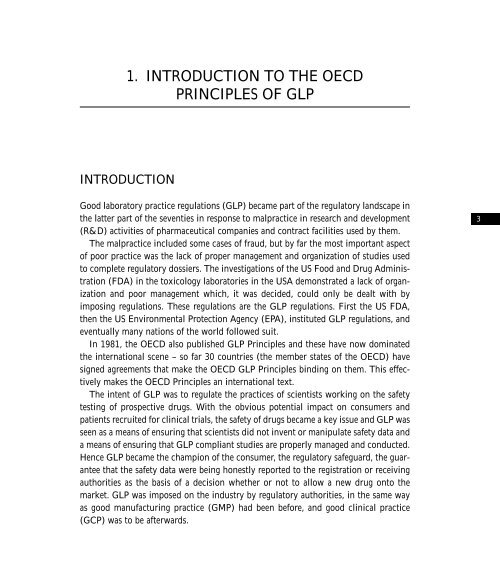TRAINEE - World Health Organization
TRAINEE - World Health Organization
TRAINEE - World Health Organization
You also want an ePaper? Increase the reach of your titles
YUMPU automatically turns print PDFs into web optimized ePapers that Google loves.
1. INTRODUCTION TO THE OECD<br />
PRINCIPLES OF GLP<br />
INTRODUCTION<br />
Good laboratory practice regulations (GLP) became part of the regulatory landscape in<br />
the latter part of the seventies in response to malpractice in research and development<br />
(R&D) activities of pharmaceutical companies and contract facilities used by them.<br />
The malpractice included some cases of fraud, but by far the most important aspect<br />
of poor practice was the lack of proper management and organization of studies used<br />
to complete regulatory dossiers. The investigations of the US Food and Drug Administration<br />
(FDA) in the toxicology laboratories in the USA demonstrated a lack of organization<br />
and poor management which, it was decided, could only be dealt with by<br />
imposing regulations. These regulations are the GLP regulations. First the US FDA,<br />
then the US Environmental Protection Agency (EPA), instituted GLP regulations, and<br />
eventually many nations of the world followed suit.<br />
In 1981, the OECD also published GLP Principles and these have now dominated<br />
the international scene – so far 30 countries (the member states of the OECD) have<br />
signed agreements that make the OECD GLP Principles binding on them. This effectively<br />
makes the OECD Principles an international text.<br />
The intent of GLP was to regulate the practices of scientists working on the safety<br />
testing of prospective drugs. With the obvious potential impact on consumers and<br />
patients recruited for clinical trials, the safety of drugs became a key issue and GLP was<br />
seen as a means of ensuring that scientists did not invent or manipulate safety data and<br />
a means of ensuring that GLP compliant studies are properly managed and conducted.<br />
Hence GLP became the champion of the consumer, the regulatory safeguard, the guarantee<br />
that the safety data were being honestly reported to the registration or receiving<br />
authorities as the basis of a decision whether or not to allow a new drug onto the<br />
market. GLP was imposed on the industry by regulatory authorities, in the same way<br />
as good manufacturing practice (GMP) had been before, and good clinical practice<br />
(GCP) was to be afterwards.<br />
3

















